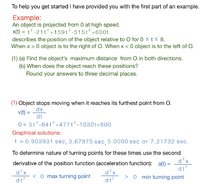You are using an out of date browser. It may not display this or other websites correctly.
You should upgrade or use an alternative browser.
You should upgrade or use an alternative browser.
Maxima & Minima Question
- Thread starter OckLuke
- Start date
Dr.Peterson
Elite Member
- Joined
- Nov 12, 2017
- Messages
- 16,869
Sure. Just show us how far you have been able to get, and explain where and why you are stuck. Then we can give the appropriate help.
What did you get for the derivative? What did you do next?
What did you get for the derivative? What did you do next?
Dr.Peterson
Elite Member
- Joined
- Nov 12, 2017
- Messages
- 16,869
Yes.
And when you aren't sure whether "the general rule" is appropriate, just try it and see how things work. You don't need to wait for permission. (That would have saved an hour ...)
To save some time, I'll ask the next question now: Are you allowed to use technology, such as a graphing calculator, to solve the resulting equation? It isn't going to be pretty.
And when you aren't sure whether "the general rule" is appropriate, just try it and see how things work. You don't need to wait for permission. (That would have saved an hour ...)
To save some time, I'll ask the next question now: Are you allowed to use technology, such as a graphing calculator, to solve the resulting equation? It isn't going to be pretty.
Otis
Elite Member
- Joined
- Apr 22, 2015
- Messages
- 4,589
Local maximums and minimums always occur at values of t where the first derivative is zero (or undefined). So, the next step after you differentiate h(t) is to set that derivative equal to zero and solve for t. Use your technology to solve that equation.Okay. I’ll [find the first derivative of function h]. I wouldn’t know where to head after that … technology use is allowed
h'(t) = 0
There are two Real solutions; one of them is the t-value at the local maximum, and the other is the t-value at the local minimum.
You can use the second-derivative test, to confirm which is which. Has your class covered how that test works?
?
Steven G
Elite Member
- Joined
- Dec 30, 2014
- Messages
- 14,603
Sorry but that is not 100% true on a closed interval, as we have in this problem. Local max and mins can occur at the endpoints and the derivative may not be 0 there..Local maximums and minimums always occur at values of t where the first derivative is zero (or undefined). So, the next step after you differentiate h(t) is to set that derivative equal to zero and solve for t. Use your technology to solve that equation.
h'(t) = 0
There are two Real solutions; one of them is the t-value at the local maximum, and the other is the t-value at the local minimum.
You can use the second-derivative test, to confirm which is which. Has your class covered how that test works?
?
Otis
Elite Member
- Joined
- Apr 22, 2015
- Messages
- 4,589
Oh my. Yes, you're spot on, of course -- thank you for posting that. (A rookie mistake: peeking first at the graph of h versus thinking in general.)… on a closed interval … max and mins can occur at the endpoints ….
?
Steven G
Elite Member
- Joined
- Dec 30, 2014
- Messages
- 14,603
I did not hear you mention anything about corner time.Oh my. Yes, you're spot on, of course -- thank you for posting that. (A rookie mistake: peeking first at the graph of h versus thinking in general.)
?
Otis
Elite Member
- Joined
- Apr 22, 2015
- Messages
- 4,589
I don't know how to calculate the time.I did not hear you mention anything about corner time.
\(\;\)



